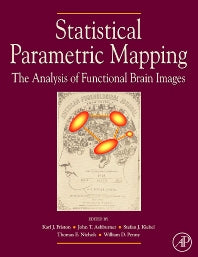Freshly Printed - allow 10 days lead
Couldn't load pickup availability
Statistical Parametric Mapping: The Analysis of Functional Brain Images
Describes the theoretical background behind Statistical Parametric Mapping and provides operational guidelines and technical details on data analysis.
William D. Penny (Edited by), Karl J. Friston (Edited by), John T. Ashburner (Edited by), Stefan J. Kiebel (Edited by), Thomas E. Nichols (Edited by)
9780123725608, Elsevier Science
Hardback, published 2 November 2006
688 pages
27.6 x 21.6 x 3.6 cm, 2.31 kg
In an age where the amount of data collected from brain imaging is increasing constantly, it is of critical importance to analyse those data within an accepted framework to ensure proper integration and comparison of the information collected. This book describes the ideas and procedures that underlie the analysis of signals produced by the brain. The aim is to understand how the brain works, in terms of its functional architecture and dynamics. This book provides the background and methodology for the analysis of all types of brain imaging data, from functional magnetic resonance imaging to magnetoencephalography. Critically, Statistical Parametric Mapping provides a widely accepted conceptual framework which allows treatment of all these different modalities. This rests on an understanding of the brain's functional anatomy and the way that measured signals are caused experimentally. The book takes the reader from the basic concepts underlying the analysis of neuroimaging data to cutting edge approaches that would be difficult to find in any other source. Critically, the material is presented in an incremental way so that the reader can understand the precedents for each new development. This book will be particularly useful to neuroscientists engaged in any form of brain mapping; who have to contend with the real-world problems of data analysis and understanding the techniques they are using. It is primarily a scientific treatment and a didactic introduction to the analysis of brain imaging data. It can be used as both a textbook for students and scientists starting to use the techniques, as well as a reference for practicing neuroscientists. The book also serves as a companion to the software packages that have been developed for brain imaging data analysis.
Part 1: Introduction Chapter 1: A short history of SPM Chapter 2: Statistical parametric mapping Chapter 3: Modelling brain responses Part 2: Computational anatomy Chapter 4: Rigid Body Registration Chapter 5: Non-linear Registration Chapter 6: Segmentation Chapter 7: Voxel-Based Morphometry Part 3: General linear models Chapter 8: The General Linear Model Chapter 9: Contrasts and Classical Inference Chapter 10: Covariance Components Chapter 11: Hierarchical Models Chapter 12: Random Effects Analysis Chapter 13: Analysis of Variance Chapter 14: Convolution Models for fMRI Chapter 15: Efficient Experimental Design for fMRI Chapter 16: Hierarchical models for EEG and MEG Part 4: Classical inference Chapter 17: Parametric procedures Chapter 18: Random Field Theory Chapter 19: Topological Inference Chapter 20: False Discovery Rate procedures Chapter 21: Non-parametric procedures Part 5: Bayesian inference Chapter 22: Empirical Bayes and hierarchical models Chapter 23: Posterior probability maps Chapter 24: Variational Bayes Chapter 25: Spatio-temporal models for fMRI Chapter 26: Spatio-temporal models for EEG Part 6: Biophysical models Chapter 27: Forward models for fMRI Chapter 28: Forward models for EEG Chapter 29: Bayesian inversion of EEG models Chapter 30: Bayesian inversion for induced responses Chapter 31: Neuronal models of ensemble dynamics Chapter 32: Neuronal models of energetics Chapter 33: Neuronal models of EEG and MEG Chapter 34: Bayesian inversion of dynamic models Chapter 35: Bayesian model selection and averaging Part 7: Connectivity Chapter 36: Functional integration Chapter 37: Functional connectivity: eigenimages and multivariate analyses Chapter 38: Effective Connectivity Chapter 39: Non-linear coupling and kernels Chapter 40: Multivariate autoregressive models Chapter 41: Dynamic Causal Models for fMRI Chapter 42: Dynamic causal models for EEG Chapter 43: Dynamic Causal Models and Bayesian selection Appendices Linear models and inference Dynamical systems Expectation maximization Variational Bayes under the Laplace approximation Kalman filtering Random field theory Index Color Plates
Subject Areas: Neurosciences [PSAN], Medical imaging [MMP], Neurology & clinical neurophysiology [MJN], Physiology [MFG], Cognition & cognitive psychology [JMR]


